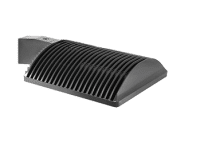
What LED Brings to the Parking Lot
The best way to explain the technological jump from HID lamps to LED fixtures is to illustrate what components go into each fixture. Here’s a quick look at each:
- HID lamps – HID lamps look like standard fixtures, though a bit longer and bulkier in spots. An HID lamp produces light by sending an electrical arc between a pair of tungsten electrodes. These electrodes are housed inside a bulb of quartz or alumina, fused together. Finally, the bulb is filled with combination of evaporated metal salts and gas. During operation, the electricity excites the gas, which heats the salts, producing plasma and a significant amount of light.
- LED fixtures – LEDs can be built into a number of form factors, and consist of a semiconductor die and a driver that converts power current to something the LED die chips can use.
The difference is easy to spot. HID lamps have many more components and rely on things like gas and evaporated salts to produce a chemical reaction. This makes them harder to manage, bulkier and more liable to break down. LEDs, on the other hand, operate using sophisticated semiconductor technology, which functions at the atomic level. It’s about as precise a form of light generation there is, and because it relies on stable circuitry and, ideally, a high quality driver, steady performance can be guaranteed over a much longer period.
That atomically precise form of light generation is also why LEDs are so efficient and why they generate so little heat. Heat, of course, is the enemy of parking lot lighting, and is what causes HID lamps to degrade as they age. It’s a common sight among street lamps and parking lot lights. The fixture blinks on with an intense bluish light, then slowly shifts to red before blinking out for a spell. This can leave large parts of the property in the dark, producing an unsafe situation. LEDs don’t degrade noticeably as they age, offering bright illumination from the moment they are installed to the moment they need to be replaced. The result is a property that is always brightly and evenly lit.
A constant frustration with property owners is having to switch out failing HID lamps, which is something that has to be done with regularity. The cost involved is significant and it takes constant babysitting from the property owner, because these lamps have to be changed out as soon as they begin failing. LED fixtures last much longer than HID lamps – on the order of tens of thousands of hours more. That’s a lot less babysitting.
An overlooked benefit of LED fixtures, especially when it comes to parking lot lighting, is how much lighter the fixtures are. It may not seem like a big deal, as parking lot poles are sturdy, but the added weight of HID lamps has to be accounted for and supported by additional anchoring on the pole. Some of this extra weight is due to the fixture itself, while some comes from the larger ballasts and additional reflectors required to operate the lamp. Also, the extra weight of HID lamps erodes the wind rating of the pole, making it more susceptible to damage by wind gusts. Along the Gulf Coast, where winds frequently rush in from the ocean, that is a real concern.
Add in the fact that LEDs are easier to control, and it’s clear that parking lot lighting has made major strides in recent years. Although LED lighting has only been viable for a couple decades, it has been improved greatly with time, and now can match HIDs in both power and photometrics.
With the help of a lighting design expert, a large property can either make the switch to LEDs or start with a brand new system. Either way, the property owner will immediately begin reaping the benefits of modern lighting technology.







